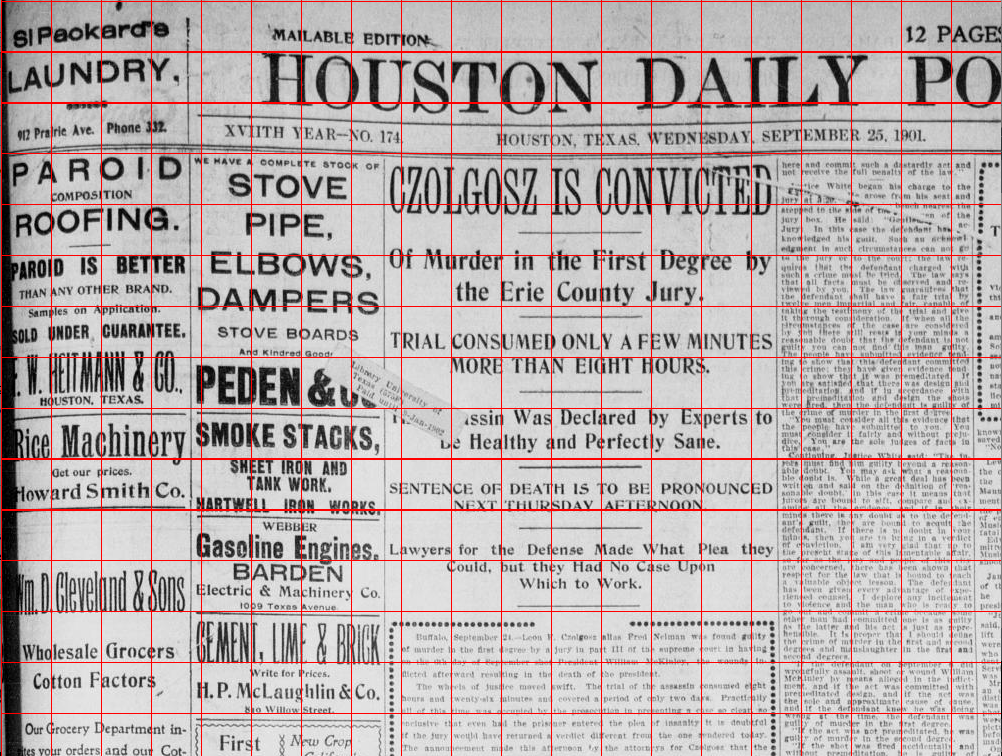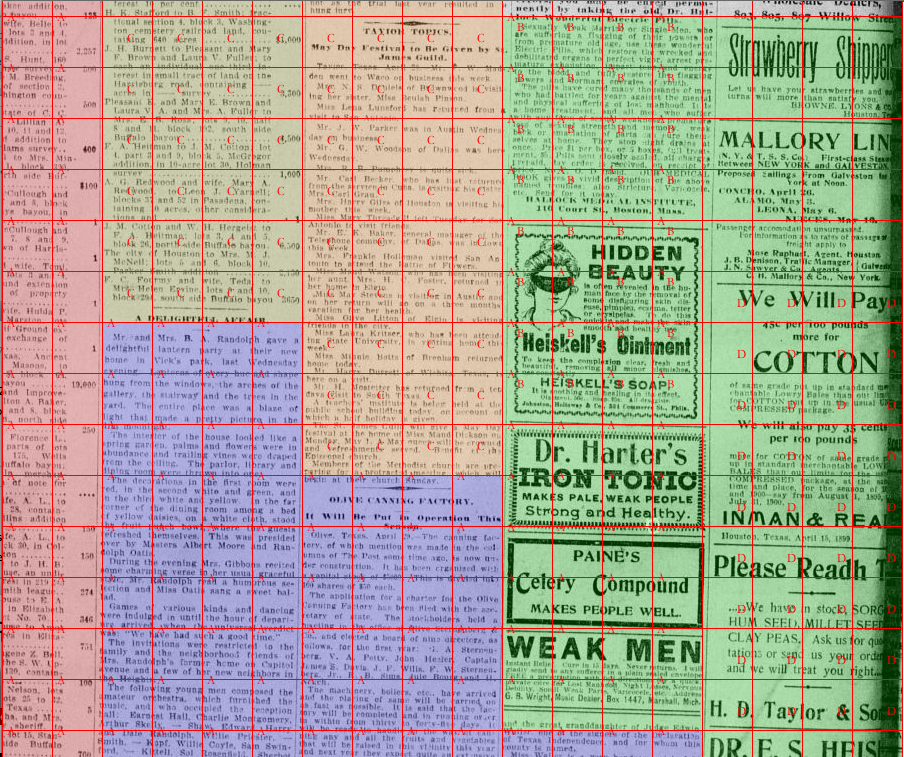Coding a Middle Ground: ImageGrid
Openness is the sacred cow of the digital humanities. Making data publicly available, writing open-source code, or publishing in open-access journals are not just ideals, but often the very glue that binds the field together. It's one of the aspects of digital humanities that I find most appealing. Despite this, I have only slowly begun to put this ideal into practice. Earlier this year, for instance, I posted over one hundred book summaries I had compiled while studying for my qualifying exams. Now I'm venturing into the world of open-source by releasing a program I used in a recent research project.
The program tries to tackle one of the fundamental problem facing many digital humanists who analyze text: the gap between manual "close reading" and computational "distant reading." In my case, I was trying to study the geography within a large corpus of nineteenth-century Texas newspapers. First I wrote Python scripts to extract place-names from the papers and calculate their frequencies. Although I had some success with this approach, I still ran into the all-too-familiar limit of historical sources: their messiness. Namely, nineteenth-century newspapers are extremely challenging to translate into machine-readable text. When performing Optical Character Recognition (OCR), the smorgasbord nature of newspapers poses real problems. Inconsistent column widths, a potpourri of advertisements, vast disparities in text size and layout, stories running from one page to another - the challenges go on and on and on. Consequently, extracting the word "Havana" from OCR'd text is not terribly difficult, but writing a program that identifies whether it occurs in a news story versus an advertisement is much harder. Given the quality of the OCR'd text in my particular corpus, deriving this kind of context proved next-to-impossible.
The messy nature of digitized sources illustrates a broader criticism I've heard of computational distant reading: that it is too empirical, too precise, and too neat. Messiness, after all, is the coin of the realm in the humanities - we revel in things like context, subtlety, perspective, and interpretation. Computers are good at generating numbers, but not so good at generating all that other stuff. My computer program could tell me precisely how many times "Chicago" was printed in every issue of every newspaper in my corpus. What it couldn't tell me was the context in which it occurred. Was it more likely to appear in commercial news? Political stories? Classified ads? Although I could read a sample of newspapers and manually track these geographic patterns, even this task proved daunting: the average issue contained close to one thousand place-names and stretched more than 67,000 words (or, longer than Mrs. Dalloway, Fahrenheit 451, and All Quiet on the Western Front). I needed a middle ground. I decided to move backwards, from the machine-readable text of the papers to the images of the newspapers themselves. What if I could broadly categorize each column of text according both to its geography (local, regional, national, etc.) and its type of content (news, editorial, advertisement, etc.)? I settled on the idea of overlaying a grid onto the page image. A human reader could visually skim across the page and select cells in the grid to block off each chunk of content, whether it was a news column or a political cartoon or a classified ad. Once the grid was divided up into blocks, the reader could easily calculate the proportions of each kind of content.
My collaborator, Bridget Baird, used the open-source programming language Processing to develop a visual interface to do just that. We wrote a program called ImageGrid that overlaid a grid onto an image, with each cell in the grid containing attributes. This "middle-reading" approach allowed me a new access point into the meaning and context of the paper's geography without laboriously reading every word of every page. A news story on the debate in Congress over the Spanish-American War could be categorized primarily as "News" and secondarily as both "National" and "International" geography. By repeating this process across a random sample of issues, I began to find spatial patterns.
For instance, I discovered that a Texas paper from the 1840s dedicated proportionally more of its advertising "page space" to local geography (such as city grocers, merchants, or tailors) than did a later paper from the 1890s. This confirmed what we might expect, as a growing national consumer market by the end of the century gave rise to more and more advertisements originating from outside of Texas. More surprising, however, was the pattern of international news. The earlier paper contained three times as much foreign news (relative "page space" categorized as news content and international geography) as did the later paper in the 1890s. This was entirely unexpected. The 1840s should have been a period of relative geographic parochialism compared to the ascendant imperialism of the 1890s that marked the United States's noisy emergence as a global power. Yet the later paper dedicated proportionally less of its news to the international sphere than the earlier paper. This pattern would have been otherwise hidden if I had used either a close-reading or distant-reading approach. Instead, a blended "middle-reading" through ImageGrid brought it into view.
We realized that this "middle-reading" approach could be readily adapted not just to my project, but to other kinds of humanities research. A cultural historian studying American consumption might use the program to analyze dozens of mail-order catalogs and quickly categorize the various kinds of goods - housekeeping, farming, entertainment, etc. - marketed by companies such as Sears-Roebuck. A classicist could analyze hundreds of Roman mosaics to quantify the average percentage of each mosaic dedicated to religious or military figures and the different colors used to portray each one.
Inspired by the example set by scholars such as Bethany Nowviskie, Jeremy Boggs, Julie Meloni, Shane Landrum, Tim Sherratt, and many, many others, we released ImageGrid as an open-source program. A more detailed description of the program is on my website, along with a web-based applet that provides an interactive introduction to the ImageGrid interface. The program itself can be downloaded either on my website or on its GitHub repository, where it can be modified, improved, and adapted to other projects.


